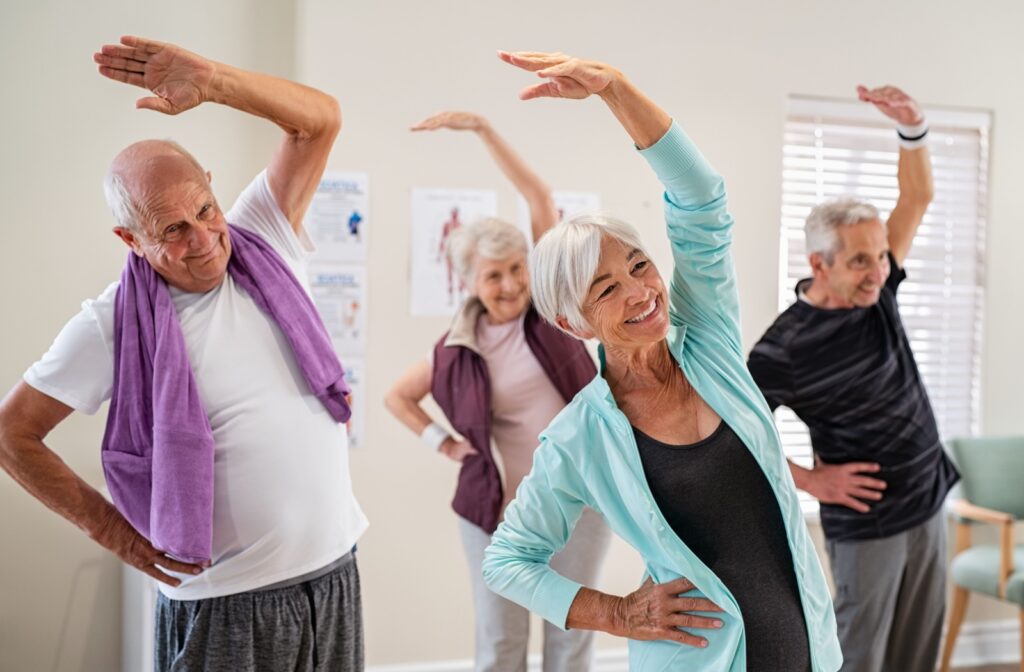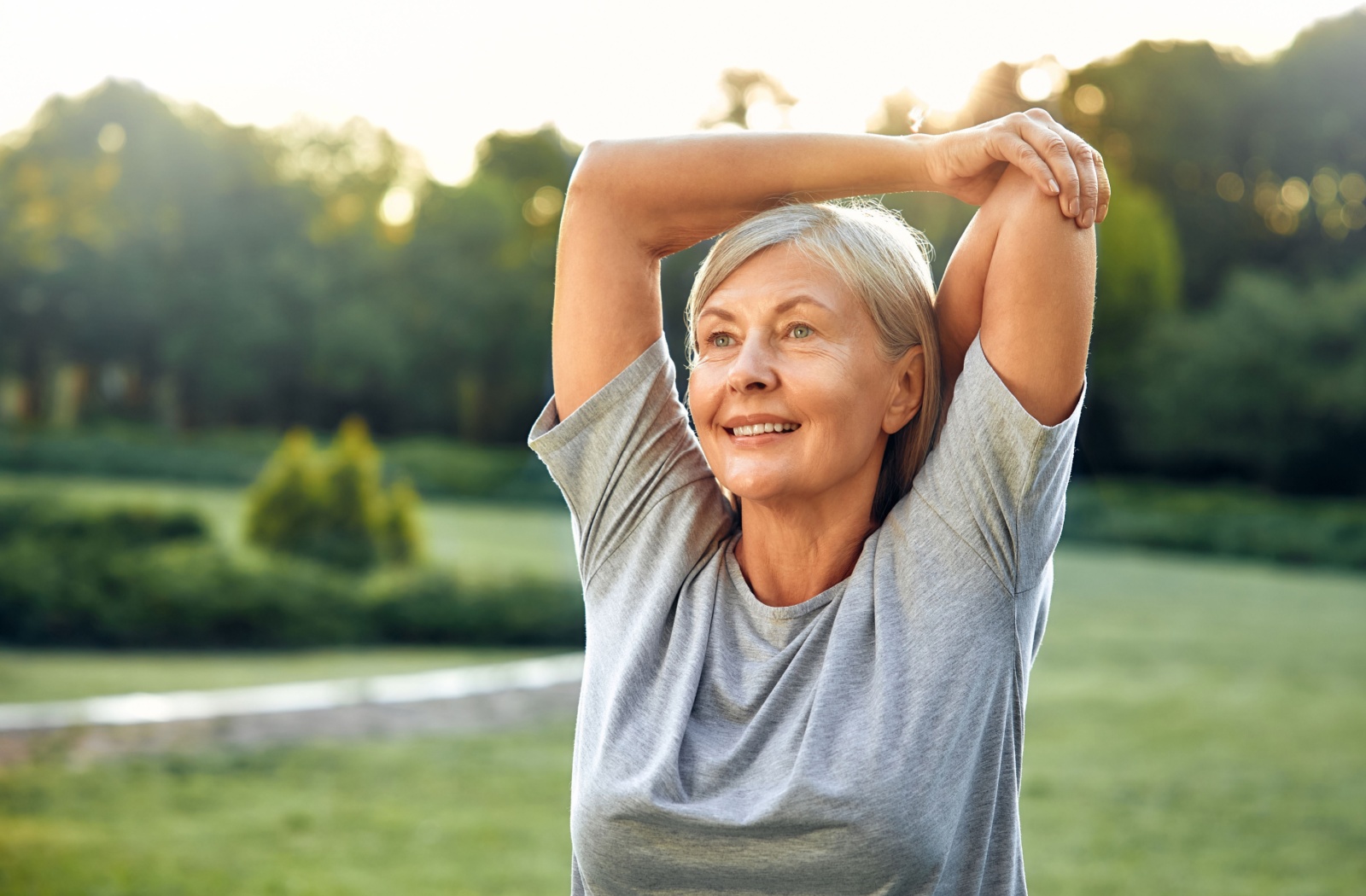As we gracefully age, maintaining our vitality becomes increasingly paramount. For seniors, flexibility is a cornerstone of a vibrant and fulfilling life. Flexibility supports mobility, prevents injury, reduces daily discomfort, promotes senior health, and encourages confidence in everyday movement.
The Often Overlooked Key to Aging Well
Flexibility is one of the most valuable yet often underestimated aspects of senior wellness. While strength and endurance often take center stage in discussions of fitness, flexibility is often the foundation of these abilities, as it supports movement, safety, and comfort. Here’s how flexibility can transform senior living:
1. Greater Range of Motion
Gentle stretching and mobility exercises help keep joints limber and muscles pliable. This allows seniors to continue performing daily tasks—like reaching a top shelf or putting on shoes—with greater ease and less strain.
2. Reduced Risk of Injury
Flexible muscles and joints are better equipped to handle unexpected movements or slips. Maintaining flexibility helps prevent sprains, strains, and even falls—common concerns that can lead to longer recovery times for older adults.
3. Relief from Everyday Aches
Many seniors experience stiffness or discomfort due to age-related changes in muscles and joints. Flexibility exercises help improve circulation, reduce tension, and ease soreness, making everyday movements more comfortable.
4. Joint Health Support
Flexible muscles help reduce stress on the joints, which is especially important for those managing arthritis or osteoporosis. Keeping muscles loose and supportive can lessen joint wear and help maintain independence longer.
5. Improved Posture & Balance
Tight or imbalanced muscles can pull the body out of alignment, affecting posture and stability. Stretching and balance-focused exercises help seniors stay upright, confident, and less likely to experience a fall.
Easy Ways Seniors Can Boost Flexibility
Improving flexibility doesn’t require extreme workouts. Here are gentle, effective ways seniors can stay limber and mobile:
- Daily stretching: Focus on major muscle groups—especially the neck, shoulders, back, hips, and legs. Hold each stretch for 15–30 seconds, breathing deeply and moving slowly.
- Try Yoga or Tai Chi: These low-impact practices are ideal for seniors, as they promote flexibility, balance, and peace of mind through guided, flowing movements.
- Stay active: Even light activities like walking or gardening help keep the body moving and the muscles from stiffening. Try to incorporate different kinds of movement throughout the week.
- Listen to your body: Don’t push too hard. If something feels painful, ease back. Gradual, consistent effort is more beneficial than forcing progress.
- Be consistent: Flexibility improves with regular practice. Aim for a few minutes a day and be patient with your progress—your body will thank you.

Frequently Asked Questions About Flexibility for Seniors
At what age should seniors start focusing on flexibility?
It’s never too early—or too late—to start. While flexibility tends to decline naturally with age, beginning a gentle stretching or mobility routine in your 60s, 70s, or even 80s can still provide noticeable improvements in comfort, balance, and mobility.
How often should seniors stretch?
Ideally, seniors should aim to stretch most days of the week, even if just for 5–10 minutes. Consistency is more important than intensity. Over time, daily stretching helps maintain muscle elasticity and joint mobility.
What’s the safest way to get started with flexibility training?
Start slow and focus on controlled, pain-free movement. Chair stretches, gentle floor exercises, or beginner-level yoga or Tai Chi classes are great places to start. Working with a physical therapist or joining a senior fitness class can also provide guidance and safety.
Can flexibility help with chronic conditions like arthritis?
Yes, absolutely. Regular flexibility exercises can reduce stiffness, improve joint function, and support pain management in conditions like arthritis. Always check with your healthcare provider to tailor activities to your needs.
What if I feel stiff every time I stretch—should I stop?
Some initial stiffness is normal, especially if stretching is new to you. However, stretches should never feel sharp or painful. Gentle discomfort is okay; pain is not. Modify the stretch or consult a professional if you’re unsure.
How Assisted Living Supports Flexibility & Wellness
Assisted living communities play a valuable role in promoting flexibility and overall well-being for seniors. With access to daily movement opportunities, wellness-focused programs, and a safe, supportive environment, these communities encourage residents to stay active in ways that suit their individual abilities.
Through guided fitness classes like stretching, yoga, or light exercise, seniors can maintain mobility and reduce stiffness. Many communities also provide access to wellness professionals and physical therapy support, helping residents manage chronic conditions while improving flexibility and balance. Just as importantly, the social and motivational aspect of group activities inspires consistency—making it easier to stay engaged in healthy habits.
This kind of environment fosters independence, reduces the risk of injury, and supports a more vibrant, fulfilling lifestyle as we age.
Flexibility Enhances More Than Just Movement
At its core, flexibility supports independence, comfort, and confidence by allowing seniors to continue doing what they love—whether that’s gardening, dancing, playing with grandkids, or simply enjoying a walk in the park.
At All American Assisted Living at Londonderry, we believe in a holistic approach to wellness, where flexibility is just one part of living a full, active, and joyful life.Ready to learn more about how we support senior wellness? Schedule a tour today and see the difference for yourself.





